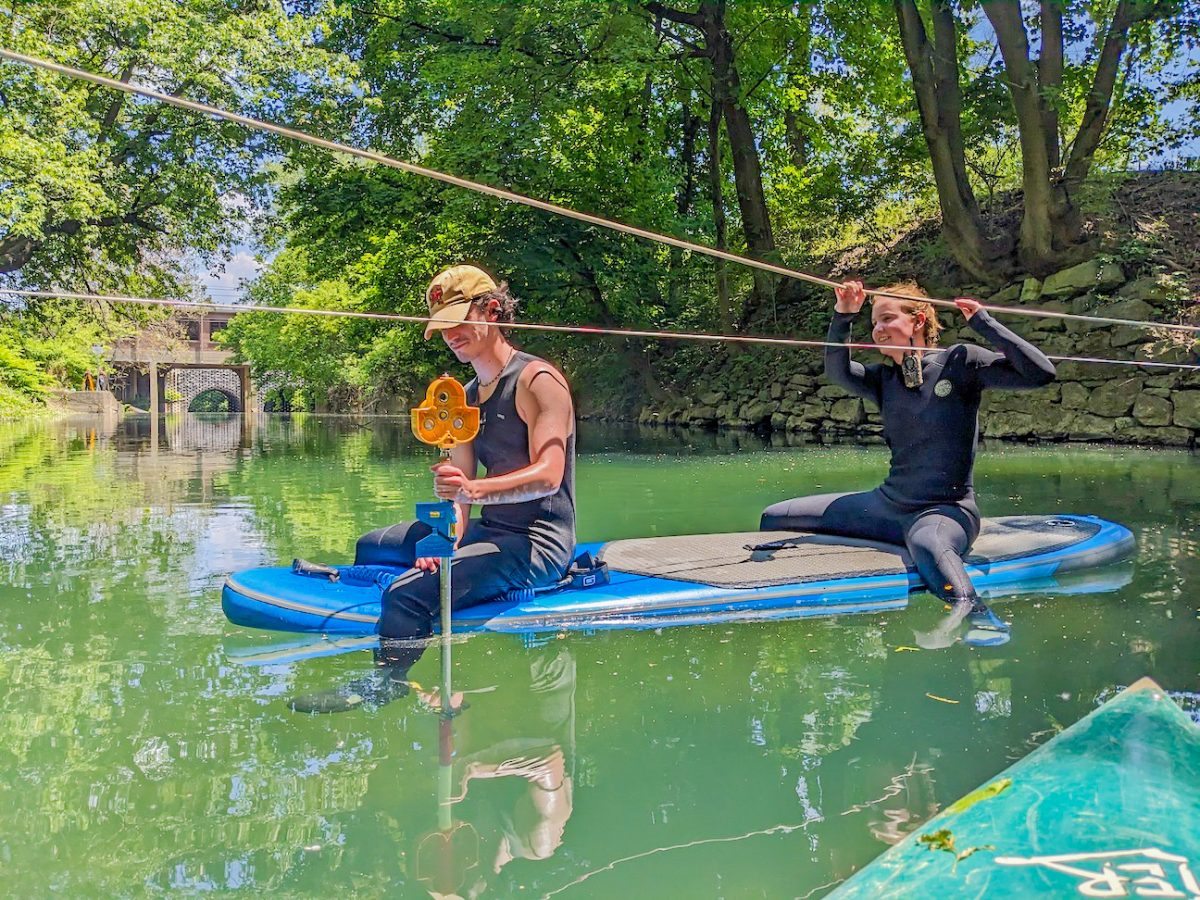This summer, the process of removing obsolete dams in Easton began, opening up a floodgate of research opportunities to students across disciplines.
The dams, which were originally built to power mills that no longer exist in Easton, have now become an outdated structure which impede on natural fish migration and increase pollutants in the Delaware River. Their removal — which began on July 7 with “Dam One” located behind Don Juan Mex Grill — comes after over a decade of research from Lafayette students and professors, including geology professor Dru Germanoski.
“There was some little part of me that was afraid it would never happen,” Germanoski said. “My students were laughing at me down there, they’re like, ‘You’re like a little kid in the playground, you’re so excited.’”
Led by Germanoski and civil engineering professor David Brandes, a group of summer EXCEL scholars went feet first into the Bushkill Creek to collect data on how the removal of Dam One affects the flow patterns and sediment movement of the creek.
The team, consisting of integrative engineering students Liam Thompson ‘24 and Andy Santopatre ‘26 and geology students Taylor Wininger-Sieve ‘26 and Elise Walsh ‘25, provided a fresh perspective on the yearslong project.
“We were able to look at a few things … with different eyes than people who had been looking at it for maybe the past couple of years,” Santopatre said. “The different perspectives of the different learning areas come in handy especially as things progress.”
Bushkill Creek’s landscape has already drastically changed as a result of the dam’s removal.
“When the dam was removed, the water level decreased significantly,” Wininger-Sieve said. “So we went from an area that would be … well above my head or anybody else’s to a place where we could just wade and get to your hips maybe.”
The team surveyed the creek using cross sections, a process that allowed them to observe how the creek eroded and changed over time. Taking cross sections required the students to get into the water with large equipment.
“[The water was] cold.” Wininger-Sieve said. “You get to feel what’s being measured … you’re trying to put together this entire thing [that] just seems like a really huge puzzle.”
“It was nice to be hands-on and constantly problem-solving,” Thompson said. “Every day was kind of like a new day because the water would be at different levels, different heights. The weather was different. The water temperature was different. We were doing it at different spaces in the creek.”
The team was able to compare their findings to over a decade’s worth of research while interpreting the data in a new way.
“It was really important that we can continue doing those processes — such as taking the cross sections — in the same exact way, as to not change the way the data is being put in,” Santopatre said. “The way we wrote things down and collected and organized our information was completely based on the way that we saw fit and the way that we would understand the information the best.”
Germanoski and Brandes will continue to monitor the stream over the next several years as it reaches an equilibrium, bringing in new teams and building upon the work of those that came before them.
“It’s also awesome that our work will just always be there,” Thompson said. “You can look at our shared drive, and there’s all these other students’ names for the previous years there that I’ve never met personally, but I’m continuing stuff that they worked on.”
The data collected at the Bushkill Creek will contribute to a global comprehension of how dam removal may impact its surrounding areas.
“Dam removal is happening globally now at a very high rate,” Germanoski said. “To be able to understand what to expect, how much a stream might change upstream [and] what the nature of the changes might be is helpful for prediction, and a lot of characterization work had to go into the stream to get permitting to have the dams removed.”
The work done this summer brings people closer to a better understanding of our planet, according to Wininger-Sieve.
“What we say in Van Wickle is ‘Once you look at things in a geologic perspective, you never really look at the Earth the same again,’” Wininger-Sieve said. “We look at how everything’s changed in the Bushkill Creek and research that and get down to the nitty gritty of what actually contributes to the way that it looks.”
The team will spend this semester researching the effects of the removal of “Dam Three,” located near Simon Silk Mill, and will move on to “Dam Two,” located near the City of Easton Recycling Center, next summer.





































































































Taylor W-S • Sep 10, 2023 at 10:37 pm
So happy to be featured! Everyone come visit Van Wickle sometime!!